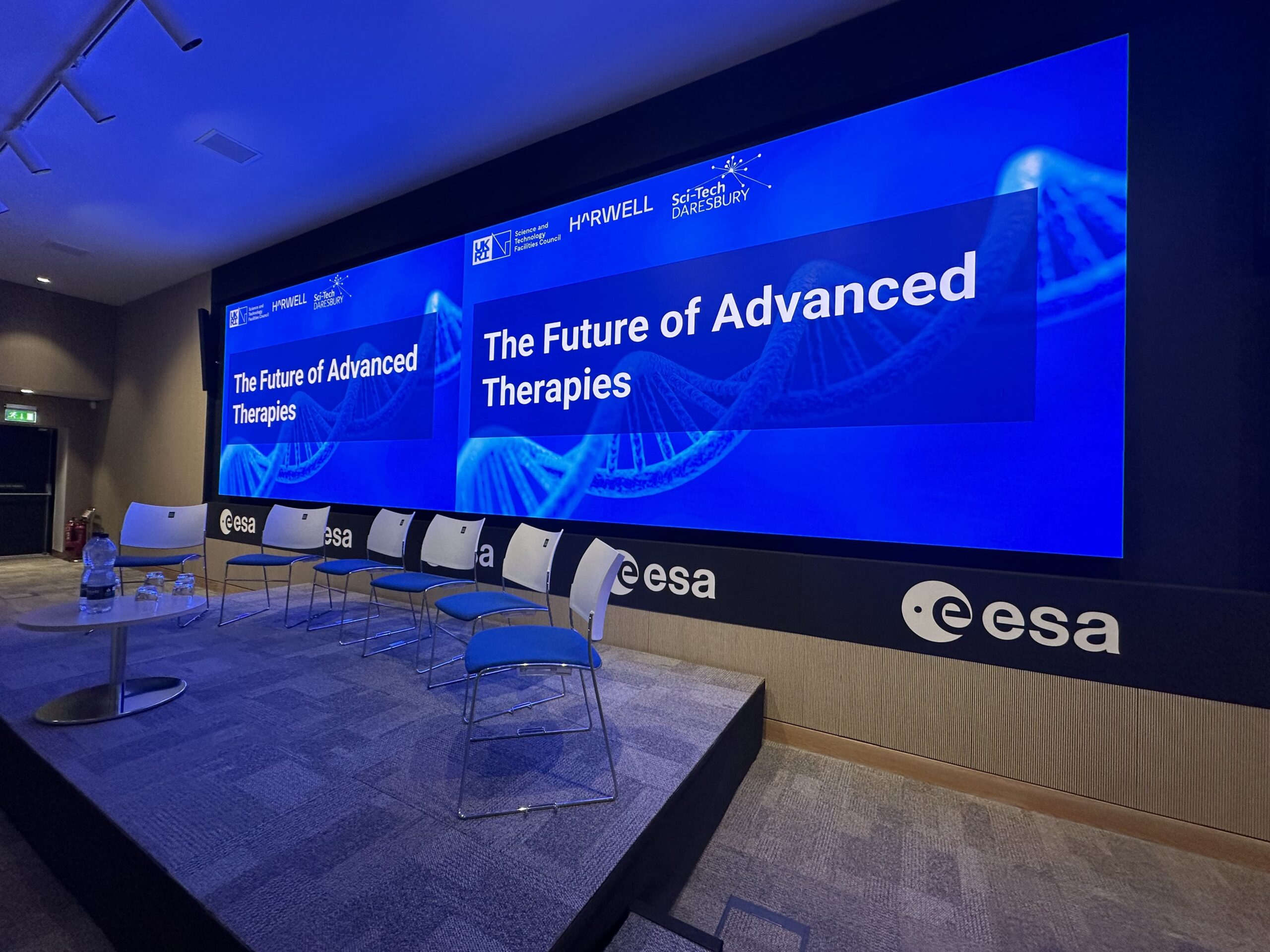
Advanced therapies and personalised medicine – an era of ‘new biology’
In an era of ‘new biology’ where we’re seeing significantly reduced timelines from research to implementation, what’s next for advanced therapies and personalised medicine?
The Future of Advanced Therapies Conference at Harwell Campus saw senior leaders from Moderna, Bayer, ARIA and iiCON, discussing advancements in therapeutics and the barriers to reaching a future where personalised medicine is the norm. Here are the key takeaways:
Medicine is becoming faster and more personalised
It was clear from the talks that it’s an exciting time to be working in life sciences. The speed taken to develop successful therapies from lab to bedside is increasing, take the malaria vaccine which took 30 years to develop, compared to Moderna’s mRNA-based vaccine which was created in 11 months. By the end of the decade, it’s anticipated that available Cell and Gene therapies in the UK will have trebled.
Thanks to technological advancements and greater understanding from research we’re seeing exponential growth in the number of therapies and treatments available. For example, the discovery of a delivery mechanism for mRNA has opened up a huge range of potential health applications and was described by Moderna’s UK medical director as “a software for life”. The software remains the same, it’s just the code that changes each time. This resulting in a quick and efficient pathway from research to production, to patient and a very versatile treatment, especially in oncology where treatment can be targeted for individual tumour types. This however poses a regulatory challenge and the need to find a way to standardise a process which is becoming increasingly personalised.
For a therapy, device, or diagnostic to reach patients, there is often a long process of rigorously translating insights into products and then testing their safety and efficacy through clinical trials. The UK has a track record in this area, both in our historic achievements and recent successes, such as the RECOVERY trials for effective Covid-19 treatments. These pandemic experiences showed the UK’s clinical research base at its best with a strong partnership of government, academia, industry, the NHS and the public, all aligned on the urgent need to develop treatments to prevent or treat an urgent health need. We’re now starting to see an increasing shift towards a platform approach to regulation and a move away from approval for individual drugs.
Health is an investment, not a cost
In recent years however the UK has been falling behind in commercial clinical trial activity with research showing that halving the number of patients in commercial clinical research activity in the last 5 years has cost the NHS in the region of £360 million. Bayer’s UK CEO said ‘it was promising to see the implementation of recommendations of the Shaughnessy report’ like the creation of clinical trial acceleration networks (CTANs). These are designed, funded, and equipped to deliver services in areas of critical strategic interest for the UK’s health and life sciences sectors. But more investment is needed to get therapies into clinical trials and practice a lot quicker. By making clinical trials and innovative therapies more available it will benefit over one million patients by taking them off the NHS waiting list which is a key driver in improving UK public health.
The creation of ARIA here could also be the answer with its mission to help fast forward research to realisation and to change perception of what is possible. Jacques Carolan a programme director at ARIA shared details of his opportunity space, which focused on unlocking the future of neurotechnologies and how targeted integration with the human brain can improve human condition through an incredibly wide range of diseases such as MND or Parkinsons.
Putting the Public at the heart of the conversation
The final piece of the puzzle comes to public buy in. At the moment treatment of rare diseases comes later in life once symptoms are visible but with the advancement in cell and gene therapies, nucleic acid therapies and the mRNA platform, we’re moving to a world where disease can be treated much earlier, even in childhood.
Undoubtedly, we need better, more frequent, and accessible science communications to ensure patients, parents and clinicians understand the next generation of therapies and are empowered to make the right decision for their health.
Professor Janet Hemmingway shared her story of how her work in tropical medicine and getting the malaria vaccine to hard-to-reach groups led her to leading a project partnering with Liverpool City Council and UKHSA to reduce vaccine hesitancy in certain populations within the city. This partnership approach and creation of community champions with football clubs in the area led to a 20% increase in vaccine uptake.
Collaboration, Collaboration, Collaboration
Across all the panel and keynote sessions, collaboration was a recurring theme, and that the barriers to advancing science and medicine could not be brought down in silos. The UK CEO of Bayer said he actively puts companies in touch to look at challenges from different angles and to help more rapidly identify solutions to diseases. This is an approach that the Health Tech cluster at Harwell Campus champions. With over 70 life sciences organisations surrounded by a further 200 organisations on Campus that specialise in space, energy and quantum, cross sector collaboration is actively encouraged with an idea in one area leading to a breakthrough in another. For example we’re increasingly seeing the integration of digital technologies with biology and in the words of the UK CEO of Bayer “it’s where the magic happens.”
Related news
-

New Quantum Cluster aims to create 1,000 high-value jobs and attract £1 billion investment over next decade
The UK’s new Harwell Quantum Cluster has officially launched today at the Harwell Science and Innovation Campus, marking a pivotal step in the nation’s ambition to lead the global quantum revolution. The cluster will accelerate quantum innovation, scale emerging technologies, and aim to create over 1,000 high-value jobs and £1 billion in investment into the…
-

Harwell launches new international alliance of leading science and technology campuses
Harwell Science and Innovation Campus is a founding member of Campus Squared, a new international alliance of leading science and technology campuses. It brings together places where world-class research facilities stand alongside shared laboratories and communities of talent, driving collaboration and breakthroughs on a global scale. The founding members are among Europe’s most advanced innovation…
-

Harwell Science and Innovation Campus marks 80 years of discovery with ‘growth engine’ plans – Powering the UK’s future in science and technology
Building on eight decades of innovation, Harwell confirms it has delivered 1 million SQF of new space since 2020 with a further 4 million SQF planned As it approaches its 80th anniversary, Harwell Science and Innovation Campus, a joint venture between the UK Government (UKAEA and UKRI-STFC) and Brookfield, continues to expand its position as the…